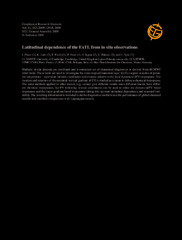Приказ основних података о документу
Latitudinal dependence of the ExTL from in situ observations
| dc.creator | Pisso, Ignacio | |
| dc.creator | Law, Kathy | |
| dc.creator | Fierli, Federico | |
| dc.creator | Hoor, Peter | |
| dc.creator | Jégou, Fabrice | |
| dc.creator | Palazzi, Elisa | |
| dc.creator | Ajtić, Jelena | |
| dc.date.accessioned | 2022-03-01T08:07:27Z | |
| dc.date.available | 2022-03-01T08:07:27Z | |
| dc.date.issued | 2009 | |
| dc.identifier.uri | https://vet-erinar.vet.bg.ac.rs/handle/123456789/2431 | |
| dc.description.abstract | Multiple in-situ datasets are combined and a consistent set of dynamical diagnostics is derived from ECMWF wind fields. These tools are used to investigate the extra tropical transition layer (ExTL) region in terms of potential temperature – equivalent latitude coordinates and distance relative to the local dynamical (PV) tropopause. The location and structure of the maximal vertical gradient of CO is studied as a mean to define a chemical tropopause. The same methods applied to other tracers (e.g. ozone) give different results since different tracers have different chemical tropopauses. Iso-PV following vertical coordinates can be used to relate the dynamical/PV based tropopause and the tracer gradient based tropopause taking into account latitudinal dependence and seasonal variability. The resulting information is intended to derive diagnostics useful to test the performance of global chemical models and establish comparisons with Lagrangian models. | sr |
| dc.language.iso | en | sr |
| dc.publisher | EGU | sr |
| dc.rights | openAccess | sr |
| dc.source | Geophysical Research Abstracts 11, April 19–24, Vienna, Austria | sr |
| dc.title | Latitudinal dependence of the ExTL from in situ observations | sr |
| dc.type | conferenceObject | sr |
| dc.rights.license | ARR | sr |
| dc.citation.spage | 12918 | |
| dc.identifier.fulltext | http://veterinar.vet.bg.ac.rs/bitstream/id/6747/EGU2009-12918.pdf | |
| dc.identifier.rcub | https://hdl.handle.net/21.15107/rcub_veterinar_2431 | |
| dc.type.version | publishedVersion | sr |

